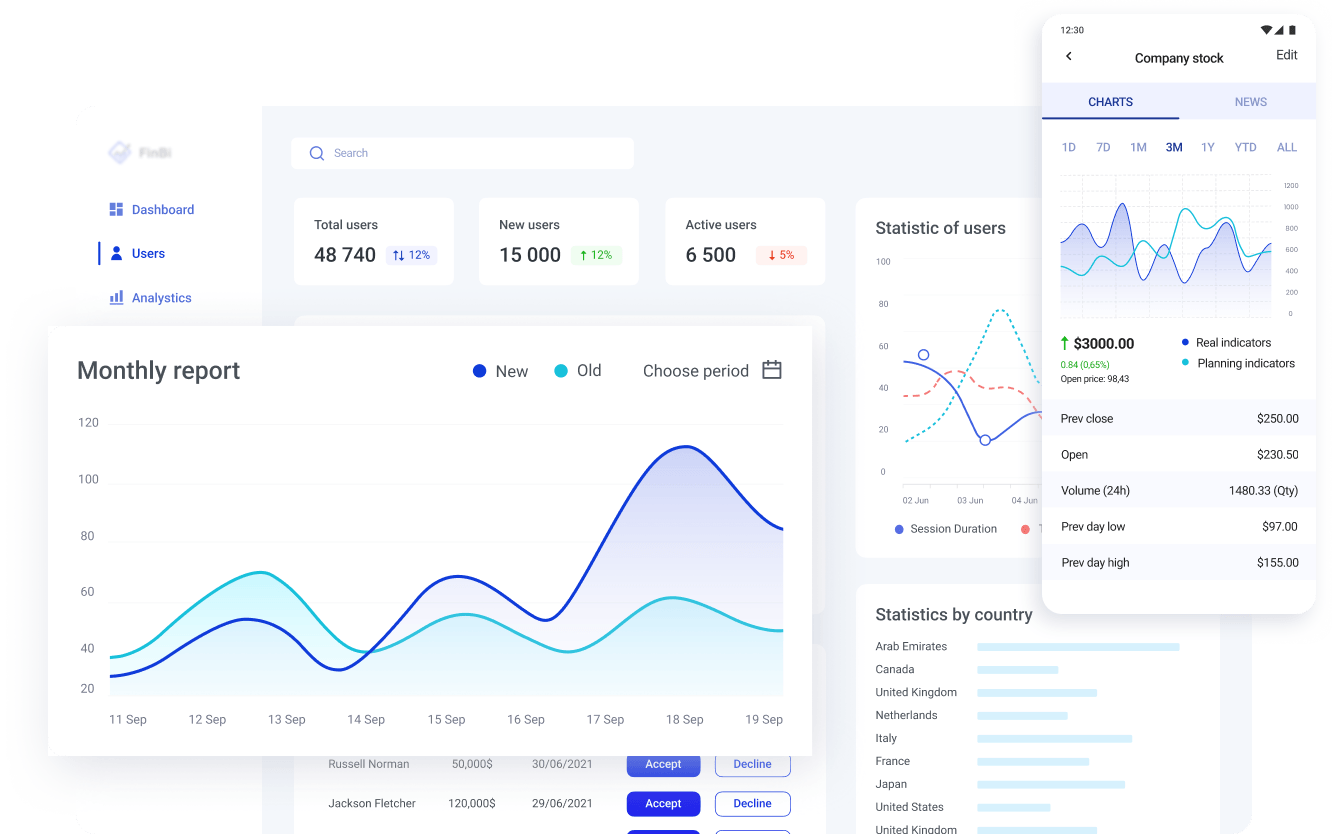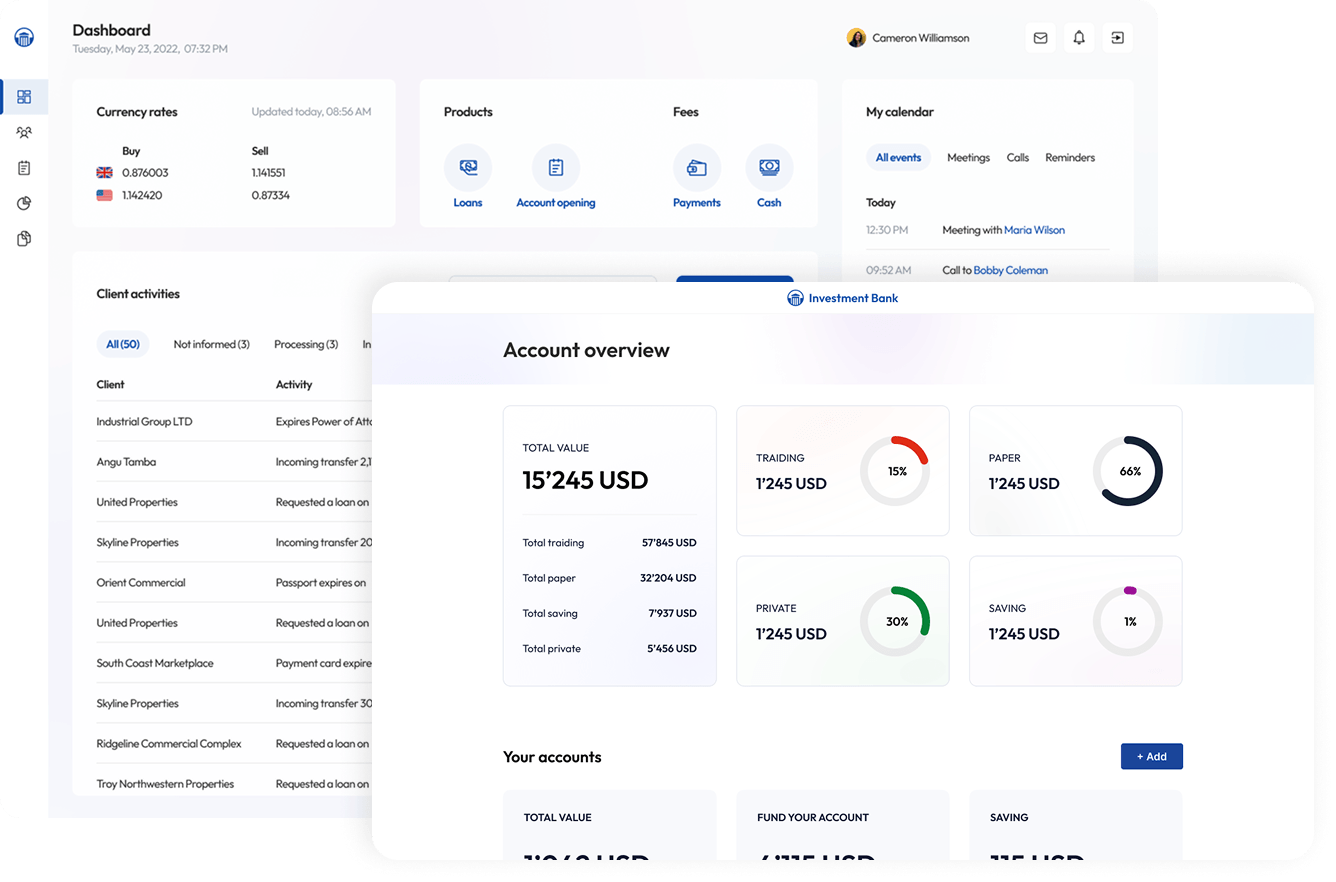FinTech Software Development Services
- Creating custom software to improve finance and banking
- Implementing payments in your FinTech applications
- Build better analytics to make smart business decisions
Featured partners
Financial software development services
we offer that you can leverage to boost your FinTech businessFinTech software solutions
we architect, build, and scale combine regulatory compliance and AI-native experiencesInnovative digital payment
- Embedded finance and PaaS
- Real-time payments and ISO 20022 rails
- Super apps and mobile wallets
- Biometric and passkey authentication
- Contactless and IoT payments
AI-powered risk systems
- Next-gen fraud detection engines
- AI-driven credit scoring
- Predictive risk analytics
- RegTech automation
- AI-powered document verification
Trading platforms
- Robo-advisory 2.0
- Digital brokerage platforms
- Tokenized assets and fractional ownership
- Market intelligence dashboards
- Social and gamified trading
Banking-as-a-service
- API-driven core banking modernization
- Digital onboarding journeys
- Omnichannel mobile-first banking
- Personal finance management
- SME and corporate banking portals
Digital asset solutions
- DeFi protocol development
- Crypto payment gateways
- Central bank digital currency enablement
- Identity and credentialing on blockchain
- Asset tokenization platforms
Embedded risk solutions
- Usage-based insurance
- Parametric insurance platforms
- Claims automation with AI
- Embedded insurance
- Digital risk assessment tools
Cleveroad’s Fintech Software Projects

Challenges solved during the creation of a Cross-Platform App to Manage Micro-Investments and Savings:
- Developing from scratch a cross-platform Flutter app for micro-investments management
- Achieving compliance with local financial regulations, including SAMA requirements for security and reporting
- Implementing advanced functionality with multi-factor authentication and automated KYC verification

Challenges solved within the building of an Online Services Ecosystem for the European Investment Bank:
- Replace the outdated MVP with a custom eBanking software ecosystem for B2B and B2C customers
- Ensuring compliance with European financial regulations, including FINMA and FMIA, through secure architecture
- Improving UI/UX design to simplify account opening, resulting in user retention rate increased by 20-30%
Financial Businesses We Serve
Financial data vendors
Fintech startups
Credit unions
Payment processing firms
Insurance firms
Wealth management firms
Brokerage firms
Investment funds
Private equity funds
Our Clients Say About Us

CTO at NURSING
"The team is very organized, communicative, and proactive. They keep the project on track and provide excellent suggestions to improve the product."
Automating FinTech Operations With AI
Computer vision
- Biometric KYC and facial recognition for digital onboarding
- Document scanning and verification (IDs, contracts, etc.)
- Fraud detection via image/video analysis (e.g., counterfeit documents)
Recommendation systems
- Intelligent product recommendations based on use patterns
- Personalized investment suggestions aligned with user risk profiles
- Adaptive cross-selling engines for banking, insurance, and trading apps
Forecasting & predictive analytics
- Market trend forecasting for investment and trading strategies
- Credit risk prediction and default probability modeling
- Demand forecasting for financial products (loans, insurance, etc.)
Natural Language Processing (NLP)
- Conversational chatbots and voice assistants for 24/7 support
- Automated compliance monitoring through document
- Sentiment analysis of customer feedback for decision support
Anomaly detection & risk intelligence
- Real-time anomaly detection in transactions to flag potential fraud
- Anti–money laundering (AML) monitoring with adaptive ML models
- Risk scoring engines for early detection of credit defaults
Generative AI for financial insights
- Automated report generation for investors and internal stakeholders
- Natural language query systems for instant access to complex data
- Personalized financial insights delivered directly to customers
Our Financial Software Building Process
- Define needs
- Solution design
- Delivery setup
- Development
Define needs
We analyze your FinTech product idea, market niche, and target audience to define functional requirements, compliance needs, and business goals. This stage ensures a shared vision of how the product will generate value and meet regulations.
Key outcomes:
Product vision document
Compliance checklist
Preliminary estimate
Product creation roadmap
Solution design
Our experts create a scalable system architecture, define data flows, and prepare clickable prototypes of user journeys such as onboarding, payments, and risk checks. This ensures the product’s usability, security, and long-term growth potential.
Key outcomes:
Feature list and MVP scope
Technical project plan
Technology stack selection
Architecture design
Interactive prototypes
UI/UX design concept
Delivery setup
We assemble the development team, plan sprints, and set up infrastructure, CI/CD, and design systems. This stage ensures transparent processes, predictable releases, and smooth collaboration between designers, developers, and QA.
Key outcomes:
Sprint and delivery roadmap
Team allocation plan
Infrastructure and process setup
Risk and dependency map
Development
Developers implement core FinTech features, from payment processing and KYC to analytics and reporting, following agile methodology. QA engineers perform continuous testing, while DevOps ensures secure deployment and smooth release.
Key outcomes:
Working FinTech product
QA and security reports
Deployed infrastructure
Handover documentation
Maintenance and support plan
FinTech software developers
from Cleveroad design solutions in line with industry rules, ensuring compliance and data securitySecurity & data standards
- DORA
- ISO/IEC 27001
- GDPR
- KYC & AML practices
- ePrivacy Regulation
- PCI DSS (incl. PCI Secure Software Standard)
Trading methods & workflows
- Central Limit Order Book (CLOB)
- IOI / RFQ / Quote workflows
- EMV
Digital identity & signatures
- SES
- UETA
- QES
- ESIGN Act
- AES
- UNCITRAL Model Law on Electronic Signatures
Financial regulations
- MiFID II
- SAMA
- PSD2
- BSA
- FINMA
- GLBA
Certifications

ISO 27001
Information Security Management System

ISO 9001
Quality Management Systems

AWS
Select Tier Partner

AWS
Solution Architect, Associate

Scrum Alliance
Advanced Certified, Scrum Product Owner

AWS
SysOps Administrator, Associate
Flexible Engagement Models We Offer
IT staff augmentation
Problem to solve:
Extend your team with the required tech expertise
Value delivered:
Expand your tech capabilities with the required IT experts
Fully manage specialists’ work as they are in your in-house team
Scale your team with a single developer or a full-stack unit
Dedicated team
Problem to solve:
Hire a development team for your FinTech project
Value delivered:
Get a pre-assembled, self-managing development team
Maintain direct communication for progress updates
Adjust team size flexibly based on project needs at any time
Custom development
Problem to solve:
Receive end-to-end FinTech development services
Value delivered:
Develop a tailored software solution aligned with your needs
Ensure a smooth development from idea validation to release
Build a scalable, high-performing product for long-term success
Industry Contribution Awards
70 Reviews on Clutch
4.9

Award
Clutch 1000 Service Providers, 2024 Global

Award
Clutch Spring Award, 2025 Global

Ranking
Top AI Company,
2025 Award

Ranking
Top Software Developers, 2025 Award

Ranking
Top Web Developers, 2025 Award

Ranking
Top Staff Augmentation Company US, 2025 Award
Cleveroad as Your FinTech Development Company
Expertise with advanced technologies
Our team applies the latest technologies to deliver innovative financial solutions. We integrate artificial intelligence into FinTech products for predictive analytics, fraud detection, customer personalization, and process automation, helping businesses gain a competitive edge
Proven track record in FinTech delivery
With 13+ years of domain experience and dozens of successful FinTech projects, we know how to address industry-specific challenges. Our portfolio includes custom payment solutions, trading platforms, and mobile banking apps, proving our ability to deliver reliable products on time.
Best practices and compliance with industry security standards
We build FinTech solutions fully aligned with the latest global regulations and security standards such as GDPR, PCI DSS, SEPA, PSD2, and other domain-specific requirements. Our approach ensures financial data safety, system reliability, usability, and seamless interoperability
Full-cycle FinTech development coverage
We provide full-cycle FinTech software development services that cover every stage of the process, from Discovery and UI/UX design to MVP development, delivery, improvements, and ongoing support, ensuring scalable products that grow with your business goals
- Outsourcing grants cost-effective access to top-tier FinTech expertise and qualified talent
- On-demand tech experience: from FinTech mobile app development to AI integration
- Much lower software development process cost
- Your in-house staff can focus on more critical tasks, such as financial management
- Chatbots
- Robo-advisors
- Fraud predictions
- Risk assessment and lending
- Better insurance recommendations
- Improved analysis of investments
- Lending software(loan origination and commercial loan)
- Banking software(online banking services and mobile banking apps)
- Insurance software(CRMs and software for agencies)
- Investment management software
- Payment processing software(payment apps)
- Personal finance software
- RegTech(risk management and fraud detection)
- FinTech solution grants valuable tools for automating workflows and making them more efficient
- Companies can receive valuable customer insights for smarter decision-making
- The client base can be increased thanks to additional interaction with the financial facility



